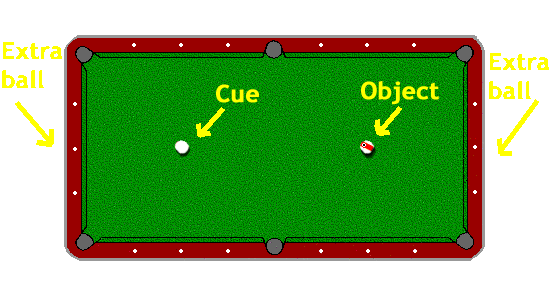CRUD
Our Crud rules as we played in Guelph (and later back home in Atlanta --
Thanks Sean!).
Play at your own risk.
Setup:
- Obtain permission to play from the establishment. In most cases,
Crud is not allowed in pool halls. Best to be friends with the staff before
you start. As luck would have it, we have a bar owner on one of our Atlanta
teams. Sean, we thank thee for allowing our humble group to play Crud at your
place of business. No innocent bystanders were hurt.
- Clear the immediate area of those innocent bystanders.
- One Object ball, one cue ball on a standard pool table. These are placed
one on each end of the table, second marker from the ends, centered on the
narrow side.

- At least one extra ball in each end of the table (in the cue return
and in ball return slot).
- Determine player order before beginning.
- A non-player may be employed as a judge. Judge's decisions are final.
- In the absense of an appointed judge, the first player knocked out becomes
the judge for the remainder of the game. Before a judge is created, all disputes
are settled by player vote.
First turn:
- Any player may call for a strike count before the roll and all players
must report the number of strikes to their name.
- The first player, called the shooter, stands at the short side with the
cue ball, takes the cue ball, and rolls it at the object ball.
- A successful hit requires the object to roll 6 inches or more.
- A successful hit requires that neither ball is sunk on the first roll.
Subsequent turns:
- The next player grabs the cue ball and rolls it at the object ball.
The centerline of the shooter's hips (also referred to as his balls) must be
past the corners at either short end of the table before grabbing the cue as
well as during the shot.

- If there is no cue ball available (it is in a pocket or off the table),
the shooter may take a ball from either end of the table and use this new ball
as the cue. Play continues with these balls until a strike is assessed.
- Other players who are still in the game may check the shooter before or
during the shot. Body checks only (from hips to shoulders). Checking players
may not hold onto the table rails.
- Shooters may take as many shots as required to hit the object ball.
- Shooters may strike the object ball in a backwards (towards themselves)
manner but may not sink it in this way.
- The object must travel more than 6 inches after any hit.
Strikes:
- If the first shooter does not make a successful hit on the object ball
within three tries, he receives a strike (6 inches or more, and not in a pocket).
- If the object ball stops rolling before it is struck by the next shooter,
that next shooter receives a strike.
- If the shooter knocks the object ball into a pocket (object must travel
6 inches) then the previous player receives the strike.
- If the shooter knocks the object ball into a pocket with less than
6 inches of travel, he receives a strike.
- Grabbing the cue while at the long sides of the table results in a strike.
- Interfering with either ball when it is not your turn results in a strike.
- Al least one foot must be on the ground during your turn (grab, aim, shoot).
One strike for lifting both feet.
- If the next shooter grabs the cue while the object ball is rolling and
the object continues on into a pocket, the one holding the cue receives the strike.
- After each strike is assessed, the table is reset to the starting condition
and play resumes with the next shooter in line taking the First Turn.
- Not being near the table for your turn (visiting the toilet during play
is dangerous) will result in a strike.
Out:
- Three strikes force a player out of the round.
- First player out becomes the judge for the remainder of the round.
- Last one out wins.
spambait


